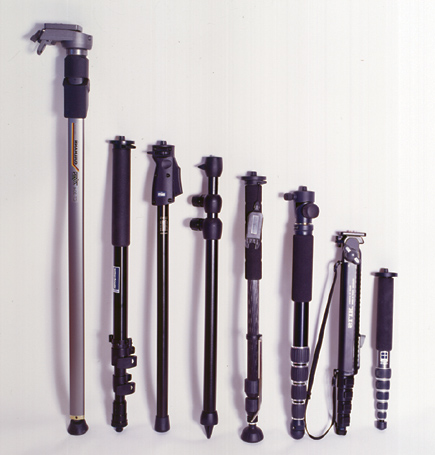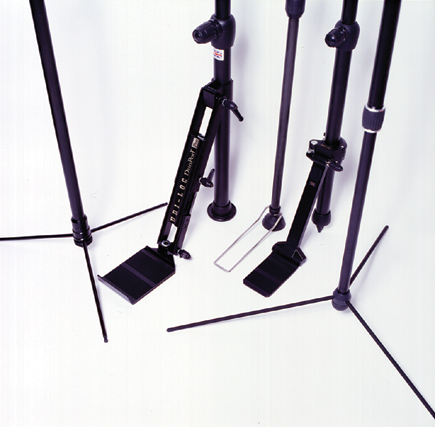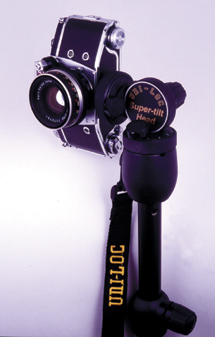Eight Unique Monopods; Multifaceted Camera Support Options
A monopod can be as simple as a walking stick with a 1/4"-20 camera screw
on top, or a high-end industrial model created for field use with professional
TV and video cameras. Yet many photographers fail to comprehend their benefits,
other than being handy for chasing the cat out from under the bed. They reason
that if you can't shoot handheld for whatever reason, then you need a
tripod. But while a tripod is frequently the ideal first choice for camera support,
it may not, according to circumstances, be the most practical solution.
Compared to a tripod, a monopod is 1) lighter; 2) less bulky; 3) faster to set
up; 4) much less likely to be prohibited in crowded public areas. OK, you say,
but isn't a monopod, by definition, 2/3 less effective than a tripod?
Well, actually, no.
 |
|
|
Consider gravity. When hand holding your camera, the lion's share of
your physical exertion is expended trying to keep gravity from smashing the
camera to the ground; not left-to-right movement, not forward or backward movement,
mainly up/down. A monopod, with a properly balanced load, totally eliminates
this vertical movement. Any remaining lateral and forward/backward motion is
a comparatively small percentage of the overall camera motion, and can be further
dampened with a few carefully chosen accessories.
Obviously, monopods do have their limitations, and I'm not for a second
advocating getting rid of your tripod. But how many pictures aren't quite
as sharp as they could be because the photographer couldn't be bothered
with setting up a tripod? Once first-hand experience is gained, many photographers
who disdain tripods can learn to tolerate the lesser encumbrance of a monopod,
and dedicated tripod users can up their quick-response batting average with
a one-legger. Indeed, most photographers will find monopods to be wonderfully
versatile shooting aids, after getting over their initial skepticism.
 |
|
|
A Monopod Sampler
So let's take a look at eight monopods, each chosen for its particular
unique attributes. Whether amazingly compact, fast to set up, or featuring clever
built-in accessories, they all stand out from their more ordinary brethren.
Please note when comparing prices that some are "street," while
others are "list," to which substantial discounts usually apply.
Cullmann Titan CT 304
Specs: Two-section; aluminum-alloy leg sections; flip-lock
leg release; 34.5" (plus 2" for supplied CT 6 head) minimum collapsed
length; 59" maximum extension without head; weight is 3.5 lbs with head;
2" platform without head; $219, list.
Special features: The CT 6 head has a 2.5x2.75" quick-release
plate; 2" swiveling rubber foot for good grip on slick flooring; leg release/lock
via large, flip-up quick-release catch; trapezoidal leg cross section; lower
segment is largest diameter, waterproof.
Pros: The two-section design, coupled with the extremely rapid
leg release, makes the CT 304 almost instantaneous to set up; construction is
robust; plastic grip easy to keep clean.
Cons: Least compact of models tested; rather heavy; included
CT 6 "no-way" head offers no tilt movement, OK for 6x6cm medium
format cameras if up/down tilt isn't needed.
Comments: Column-to-head attachment is proprietary via mating
serrated surfaces (the ultimate anti-twist solution), requires CT 74 connection
plug to adapt other makes of heads.
 |
|
|
Giottos Professional MM8950
Specs: Three-section; carbon-fiber leg sections; twist-lock
leg releases; 24" minimum collapsed length; 59.5" maximum extension;
weight is 1.4 lbs; 2.25" platform; foam grip; $128, list.
Special features: Spring-loaded, folding foot brace for added
lateral stability; 2"-plus, swiveling large rubber foot for slick-floor
traction; foam grip; tool kit included.
Pros: Very lightweight; economical price point for carbon fiber.
Cons: Due to low attachment point on leg, foot brace not as
effective as more elaborate Uni-Loc accessory foot braces (which require a monopod
with greatest leg diameter on bottom section).
Comments: Rubber foot unscrews, accepts accessory FP-2021 Multifunction
Shoe and FP-3021 Snow Shoe.
Giottos P-Pod MM5570
Specs: Five-section; aluminum leg sections; twist-lock leg
releases; 23" minimum collapsed length; 72" maximum extension; weight
is 2.7 lbs; 1.5" camera platform; foam grip; $93, list.
Special features: Bottom tip unscrews, stores set of three
separate legs that screw into tip, allows monopod to stand without assistance;
can screw two of the legs into base of head for use as bipod or wall brace;
built-in tilt head with round quick-release plate.
Pros: Heavy-duty construction; multiple bracing options; with
feet installed, both hands are free to change lenses and film or media cards.
Cons: A bit heavy.
Comments: Very versatile "straight out of the box" with
no additional accessories; robust head adequate for heavier cameras; slightly
loosening lock screw of quick-release plate allows rotating for fast vertical
camera orientation; accepts accessory Multifunction and Snow Shoes.
 |
|
|
Gitzo G1566 Mk 2
Specs: Six-section; aluminum leg sections; twist-lock leg releases;
15" minimum collapsed length; 54.5" maximum extension; weight is
1.5 lbs; 2.25" platform; foam grip; $126.95, street.
Pros: Lightweight; extremely compact.
Cons: Its five twist-locks make it slow to deploy; by far the
shortest model reviewed at maximum extension, could be problematic for tall
photographers.
Comments: Top candidate for transport in carryon luggage or
camera bags.

































